Nebulas |
|
Eta Carinae Nebula or NGC 3372 | |  Automatic translation Automatic translation | | Updated June 01, 2013 |
Hull nebula is cataloged under the reference NGC 3372, it covers approximately three degrees of the sky at the distance of 8800 years light, what corresponds to a diameter of 460 years light.
It can be observed in the bare eye. It is the region HII We call regions HII, nebulas to emission constituted by clouds mainly consisted of hydrogen and with which most of the atoms are ionized, and sometimes extending over several light years. The ionization is produced by the nearness of one or several very warm stars, spectral type O or B, which shine strongly in the extreme ultraviolet ray, so ionizing the gas surrounding, from which these stars originally formed. (region of ionized hydrogen) the most brilliant of the Milky Way. Its angular diameter exceeds 4° on photography.
The small said dark nebula of the " Hole of lock ( Keyhole) " (the cloud absorbing in the center of the nebula) juxtaposes on the most brilliant part of the nebula where the star a hour Carinae nests there. | | The nebula of the Hull is a huge nebula situated in the Arm of the Sagittarius of our Galaxy.
Although situated far from us, it is rather brilliant to be seen to the naked eye (but only since the southern hemisphere). Image: The nebula NGC3372 Eta Carinae DSS image
| | 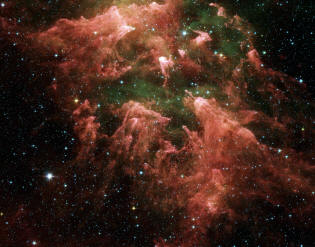 |
Horseshoe Nebula or M17 | | | | |
M17 is a nebula in emission discovered by Cheseaux in 1746 then rediscovered by Messier in 1764 situated in the Sagittarius.
Also known under the names of nebula Omega, the Swan, the Horseshoe, or the Lobster, this very brilliant nebula, about the pinkish colors, is visible in the bare eye under the low latitudes (magnitude is similar 6). This is of for the fact that it shelters young stars arisen from the nebula and which irradiate the gas surrounding, so creating a region HII We call regions HII, nebulas to emission constituted by clouds mainly consisted of hydrogen and with which most of the atoms are ionized, and sometimes extending over several light years. The ionization is produced by the nearness of one or several very warm stars, spectral type O or B, which shine strongly in the extreme ultraviolet ray, so ionizing the gas surrounding, from which these stars originally formed. , a red color of the nebula is moreover that some ionized hydrogen.
In infrared, we were able to observe an important quantity of dusts, favorable to the formations of stars there. Within the nebula would be an opened heap constituted by around thirty stars masked by the nebula. The diameter of the nebula borders 40 light years. The total mass of the gas which forms the nebula Omega is about 800 times that of the Sun. This gas extends over more than 40 light years. | | M17 is situated in 5500 years light of our solar system. M16 and M17 would be in the same spiral arm of the Milky Way (the arm of the Sagittarius or Sagittarius-hull) and are maybe a part of the same complex giant of clouds of interstellar matter. Image: The horseshoe nebula. | | 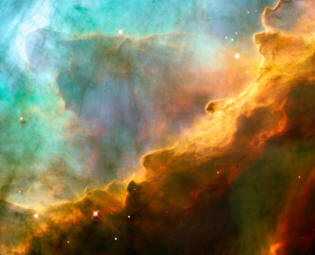 |
Nebula of Pleiades or M45 | | | | |
Pleiads, or heap M45, are a heap opened by stars which observes in the north hemisphere, in the constellation of the Taurus.
The origin of the name "Pleiades" results from the Greek mythology: Pleiades are seven sisters, girls of Atlas and Pleione: Asterope, Merope (or Dryope, or Aero), Électre, Maïa, Taygete, Celaeno (or Selene) and Alcyone.
We count approximately 500 stars today composing this heap, a dozen of which is visible in the bare eye. It extends over 2 °, is the equivalent of 4 times the visible diameter of the Moon.
Its density is thus relatively weak with regard to the others heap opened. The age of the heap is estimated at 100 million years, but he should not live for a long time because he should part in 250 million years, partially because of his weak density. | | Image: Nebula of Pleiades | | 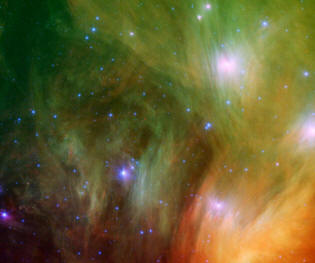 |
Eagle Nebula the or M16 | | | | |
The spatial telescope very often photographed the Eagle nebula.
Already the image acquired in 1995 showed very fine details inside its pillars of gas, real stellar crèches.
By far, that looks like an eagle.
A more attentive examination of the Nebula of the Eagle, the watch than brilliant region is really a window in the center of a bigger dark shell of dust.
Through this window, a very floodlit studio appears there where a whole heap opened by stars is forming.
In this cavity, high pillars and the round globules of dark dust and cold molecular gas live there where stars continue to form.
Several young blue brilliant stars are already visible. Their light and their winds blow the remaining strands as well as the walls of gas and dust.
The Eagle nebula by emission, labeled M 26, is situated in approximately 6 500 light years of the Earth, covers approximately 20 light years and is visible with binoculars in the direction of the Snake constellation. | | Image: Eagle Nebula or M16.
The image opposite combines three colors emitted specifically and was taken by the telescope of 0,9 m of Kitt Peak, in Arizona, in the USA. | | 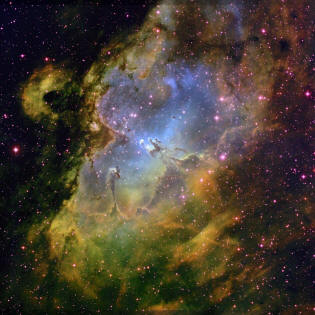 |
 Automatic translation
Automatic translation






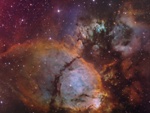 Heart and soul nebula
Heart and soul nebula
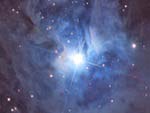 Clouds of dust
Clouds of dust
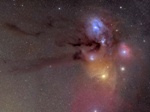 Black River of the Giant Antares
Black River of the Giant Antares
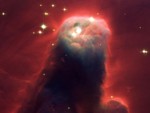 Cone Nebula, nightmare creature
Cone Nebula, nightmare creature
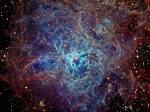 Gigantic Tarantula Nebula
Gigantic Tarantula Nebula
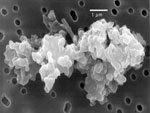 Interstellar dust
Interstellar dust
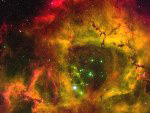 The sculpture of the Rosette
The sculpture of the Rosette
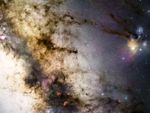 Journey to the center of our galaxy
Journey to the center of our galaxy
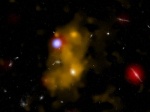 Lyman-α blob
Lyman-α blob
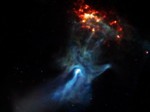 The pulsar which evokes an outstretched hand
The pulsar which evokes an outstretched hand
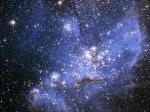 The nebula NGC 346 in the Toucan
The nebula NGC 346 in the Toucan
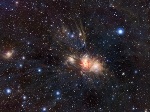 Nebula NGC 2170 seen by VISTA
Nebula NGC 2170 seen by VISTA
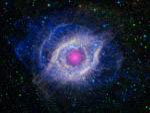 Helix Nebula, God's Eye
Helix Nebula, God's Eye
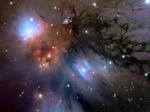 The most beautiful nebulae
The most beautiful nebulae
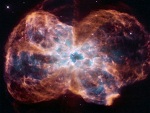 The death of stars seen by hubble
The death of stars seen by hubble
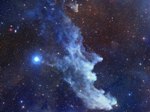 Witch's Head Nebula
Witch's Head Nebula
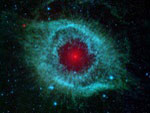 Type of nebulae, emission, reflection
Type of nebulae, emission, reflection
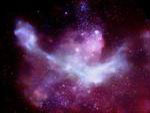 The X-rays emitted by the Carina
The X-rays emitted by the Carina
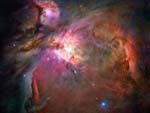 The famous Orion Nebula
The famous Orion Nebula
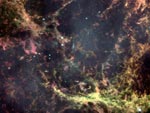 In the heart of the Crab
In the heart of the Crab
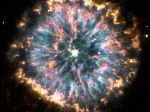 Planetary nebulae
Planetary nebulae
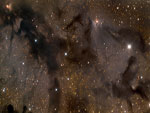 The light and dark of nebulae
The light and dark of nebulae